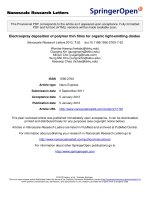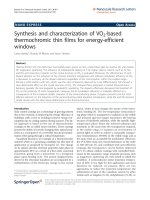Resistance switching behavior of ZN0 thin films for random access memory applications
Bạn đang xem bản rút gọn của tài liệu. Xem và tải ngay bản đầy đủ của tài liệu tại đây (580.47 KB, 5 trang )
TAẽP CH PHAT TRIEN KH&CN, TAP 16, SO K1- 2013
RESISTANCE SWITCHING BEHAVIOR OF ZnO THIN FILMS FOR
RANDOM ACCESS MEMORY APPLICATIONS
Trung Do Nguyen(1), Van Thuy Dao(2), Kim Ngoc Pham(1) , Thi Kieu Hanh Ta(1), Tran Le(1), Tuan
Tran(1), Van Hieu Le(1), Jaichan Lee(3), Mau Chien Dang(4), Bach Thang Phan(1)
(1) University of Science, VNU-HCM
(2) TrungVuongHigh SchoolTp. HCM
(3) Sungkyunkwan University, South Korea
(4) Laboratory for Nanotechnology, VNU-HCM
((Manuscript Received on April 5th , 2012, Manuscript Revised May 15th, 2013)
ABSTRACT: We investigated resistance switching behavior of the Ag/ZnO/Ti structures for
random access memory devices. These films were prepared on glass substrate by dc sputtering
technique at room temperature. The resistance switching follows unipolar switching mode with small
switching voltages (0.4 V 0.6 V). Our results figured out that the Ag/ZnO/Ti/Glass structure is a
candidate structure for nonvolatile data storage applications.
Keywords: Resistance switching, random access memory, sputtering, ZnO
MIM structure reversely changes between the
1.INTRODUCTION
high resistance state (HRS) and the low
Resistance
random
access
memory
(ReRAM) has attracted extensive attention for
their applications to nonvolatile data storage
technologies due to its simple structure, low
power consumption, low cost, nonvolality and
high speed performance [1-12]. The resistance
switching was observed from various materials,
resistance state (LRS), corresponding to logic
signal (off and on states or 0 and 1 states). Two
switching modes, unipolar switching and
bipolar switching, have been observed to
describe the switching between HRS and LRS.
Although the resistance switching effect can be
obtained in various materials, the origin of
such as perovskite oxides (Pr0.7Ca0.3MnO3,
resistance switching is controversial. The clear
La0.7Ca0.3MnO3, Cr-doped SrZrO3, Cr-doped
explanation of resistance switching in various
SrTiO 3) [1-9], transition metal oxides (NiO,
materials is the challenge and motivation for
Ti,
CuO,
ZrO2,
ZnO)[10-12].
The
resistance switching effect is regarded as
memory effect. The memory effect can be
observed
from
the
current
voltage
characteristics of metal insulator metal
current research. We have already published
our research on the resistance switching effect
in Pt/Cr-doped SrTiO3/La0.5Sr0.5CoO 3 structure
[5-9]. In this study, we reported resistance
switching
behavior
in
the
Ag/ZnO/Ti
structure (MIM), in which resistance of the
Trang 81
Science & Technology Development, Vol 16, No.K1- 2013
structure
for
nonvolatile
data
storage
applications.
2. EXPERIMENTS
The
Ag/ZnO/Ti/Glass
structure
was
fabricated by sputtering technique at room
temperature, ZnO thin film was sandwiched
between top (Ag) and bottom (Ti) electrode
materials. A 150 nm-thick metallic Ti layer
Figure 1. Schematic diagram of the Ag/ZnO/Ti
structure
was deposited on a commercial glass substrate
in Ar gas ambient of 6x10-3 Torr, depositing
3. RESULTS AND DISCUSSION
current ITi = 1 A, while the 100 nm-thick ZnO
layer was deposited in Ar + O2 (Ar/O2 = 1)
mixed gas ambient of 6x10-3 Torr, depositing
current IZnO = 0.3 A. The Ag top electrode of
75 nm-thick was deposited on the ZnO thin
film in Ar gas ambient of 6x10-3 Torr,
depositing current IAg = 0.15 A. During the
deposition of Ag layer, a mask was used for top
electrode patterning. The size of Ag top
electrode is 1 mm in diameter. Current-voltage
(I-V) measurements were carried out using a
Keithley 2400 source meter. During the
electrical measurement, the positive sweep
voltage is applied to the Ag top electrode,
while the Ti bottom electrode is grounded. The
thickness of these films was determined by
Dektak 6M Stylus Surface Profilometer. The
crystalline phases of the thin films were
characterized in -2 mode by D8 Advance
(Bruker) x-ray diffractometer (XRD) with Cu
Kα radiation (λ = 0.154 nm). The depositing
process and crystalline analysis will be
presented elsewhere.
Trang 82
As-prepared Ag/ZnO/Ti/Glass structures
were initially in a high resistance state (HRS).
To find out the switching voltages, we
increased sequently the largest sweeping
voltage Vmaz (Vmax = 0.1 V, 0.15 V, 0.2 V…)
to observe the set process. Compliance current
of 100 mA was applied to prevent permanent
structure breakdown. Figure 2 shows the I-V
characteristics of the set and the reset process.
In the 0 to 0.45 V sweeping, corresponding to
the black line (Vmax = 0.45 V), a sudden current
increase (resistance decrease) from HRS to low
resistance state (LRS), was observed at about
VSET ~ 0.42 V, the LRS remained until the end
of the sweeping. This sweeping switched the
structure into LRS, corresponding to “set”
process.
TAẽP CH PHAT TRIEN KH&CN, TAP 16, SO K1- 2013
sweeping voltage, not polarity. In the following
sweeping, the unipolar resistance switching
could
be
observed repeatedly.
In these
sweeping, a small dispersion in the value of
switching voltage was found along with a
visible and non-overlapped memory window,
which are important for nonvolatile memory
applications.
Figure 2. I-V characteristics of the set and Reset
The two above experiments figured out the
process.
set voltage and reset voltage. To observe the
The Ag/ZnO/Ti/Glass structure now is in
LRS. The next sweeping process from 0 to
Vmax (0.1 V, 0.15 V, 0.2 V.) was applied to
the structure to observe the reset process,
corresponding
to
a
red
line.
The
I-V
characteristic in this process is different from
that in the set process above (0 to 0.45 V). The
value of current of the reset process is higher
than the current value of the set process
measured at the same voltage. In the 0 to 0.6 V
sweeping process, current increased linearly
with sweeping voltage until 0.51 V, then
resistance switching (HRS LRS and LRS
HRS) in one sweeping process, we applied the
0 to 0.6 V sweeping. Figure 3 shows the I-V
characteristics of Ag/ZnO/Ti/Glass structures
in
the
0
to
0.6
V
sweeping.
The
Ag/ZnO/Ti/Glass structure was now in a HRS.
Similar to these two above experiments, we
observed the two resistance switchings in the
range of 0.4 0.6 V, HRS LRS at 0.42 V
and HRS LRS at 0.55 V. The small
switching voltages are suitable for electronic
device applications.
current gradually decreased. An abrupt drop of
current could be observed at voltage of 0.55 V
(VRESET ~ 0.55 V), the structure switched back
to HRS.
The set and reset process correspond to the
write and erase data in storaging device.
We can observe the memory effect or memory
window (two current values at a certain
voltage) in the voltages below VSET. The I-V
Figure 3. I-V characteristics of the Ag/ZnO/Ti
curve with a triangle shape is visible, similar to
structure in the 0 to 0.6 V sweeping
the model of memristive system analyzed by
Figure 4 show the current evolution of the
Srtukov et al [13]. The resistance switching is
HRS and LRS within 10 switching cycles. The
in unipolar mode, the switching between HRS
current values were read out at 0.25 V in each
and LRS only depends on magnitude of
Trang 83
Science & Technology Development, Vol 16, No.K1- 2013
sweep. The values of HRS show a small
fluctuant, while the values of LRS fluctuate in
large range. The current ratio of HRS and LRS
is above 5, which is lower than the reported
value of 10 in some published results [10,12].
In order to increase the ratio, the effect of the
depositing oxygen pressure of ZnO thin films
on the ratio switching is underdoing.
4. CONCLUTIONS
The Ag/ZnO/Ti structures were prepared
on glass substrate by dc sputtering technique.
The resistance switching behavior of the
Ag/ZnO/Ti/Glass structure was demonstrated.
The resistance switching follows unipolar
switching mode, the resistance switching
depends on magnitude of external electric field
but not on polarity. The small switching
voltages figured out that the Ag/ZnO/Ti/Glass
structure is a candidate structure for nonvolatile
data storage applications.
Figure 4. Memory window of the Ag/ZnO/Ti
structure
ĐẶC TRƯNG ĐẢO ĐIỆN TRỞ CỦA MÀNG MỎNG ZnO ỨNG DỤNG TRONG BỘ
NHỚ TRUY CẬP NGẪU NHIÊN
Nguyễn Trung Độ(1), Đào Vân Thúy(2), Phạm Kim Ngọc(1) , Tạ Thị Kiều Hạnh(1), Lê Trấn(1), Trần
Tuấn(1), Lê Văn Hiếu(1), Lee Jaichan(3), Đặng Mậu Chiến(4), Phan Bách Thắng(1)
(1)Trường Đại học Khoa học Tự nhiên, VNU-HCM
(2) Trường Phổ thông Trung học Trưng Vương Tp.HCM
(3) Trường Công nghệ và Khoa học Vật liệu tiên tiến, Đại học Sungkyunkwan, Hàn Quốc
(4) Phòng thí nghiệm Công nghệ Nano, VNU-HCM
Tóm tắt: Chúng tôi đã khảo sát đặc trưng thay đổi điện trở của cấu trúc vật liệu Ag/ZnO/Ti
nhằm ứng dụng trong bộ nhớ truy cập ngẫu nhiên. Các màng mỏng trong cấu trúc trên được chế tạo
bằng phương pháp phún xạ dc tại nhiệt độ phòng. Đặc trưng đảo điện trở của màng mỏng ZnO tuân
theo dạng đơn cực với thế đảo điện trở có giá trị từ 0.4 V – 0.6 V. Kết quả thu được chứng tỏ rằng cấu
trúc vật liệu Ag/ZnO/Ti có thể ứng dụng trong thiết bị lưu trữ dữ liệu không khả biến.
Từ khóa: Đảo điện trở, Bộ nhớ truy cập ngẫu nhiên, Phún xạ, Màng mỏng ZnO
Trang 84
TAẽP CH PHAT TRIEN KH&CN, TAP 16, SO K1- 2013
[7].
REFERENCES
[1].
C. Rossel, G.I. Meijer, D. Bremaud, D.
Oxygen Efficient Layer on Resistance
Widmer, Electrical conduction distribution
Switching in Cr-doped SrTiO3 Thin Films,
across metal insulator metal structure
Appl. Phys. Lett. 93, 222906 (2008).
during bistable switching, J. Appl. Phys.
[2].
G. Meijer, I.U. Staub, M. Janousch, S.L.
Films, J. Korean Phys. Soc. 54, 873
Johnson, B. Delley and T. Neisius,
(2009).
B. T. Phan, J. Lee, Non-adiabatic small
polaron
Phys. Rev. B 72, 155102 (2005).
reduced Cr-doped SrTiO3-delta Thin Films,
A. Odagawa, H. Sato, I.H. Inoue, H.
Appl. Phys. Lett. 94, 232102 (2009).
Akoh,H. Kawasaki, M.Y. Tokura, T.
[10]. Shibing Long, Qi Liu, Hangbing Lv,
H.
Adachi,
Colossal
tunneling
conduction
in
Yingtao Li, YanWang, Sen Zhang, Wentai
electroresistance of a Pr0.7Ca0.3MnO3 at
Lian,
room temperature, Phys. Rev. B 70,
Hongwei
224403 (2004).
switching mechanism of Ag/ZrO2:Cu/Pt
A. Sawa, T. Fujii, M. Kawasaki, Y.
memory cell, Appl. Phys. A.
Tokura, Interface resistance switching at a
(2011).
Kangwei
Xie,
Zhang,
Ming
MingWang,
Liu,
Resistive
102, 915
[11]. Young Ho Do, June Sik Kwak and Jin Pyo
active layers,Appl. Phys. Lett. 88, 232112
Hong,
(2006).
Nonvolatile
B. T. Phan, T. Choi, and J. Lee, Trap-
Resistive Switching Characteristics in Co-
Controlled Space - Charge - Limited
doped TiO2 Thin Films with Different
Current Conduction in the Cr - doped
Compliance Currents, J. Korean Phys.
SrTiO3 Thin
Soc. 5, 1009 (2009).
Films
Deposited
by
Using Pulsed Laser Deposition,J. Korean
[6].
[9].
metal transition in Cr-doped SrTiO3,
few nanometer thick perovskite manganite
[5].
B. T. Phan, N. C. Kim, J. Lee, Ac
Conductivity of Cr-doped SrTiO3 Thin
Kanno,
[4].
[8].
90, 2892 (2001).
Valence states of Cr and the insulator to
[3].
B. T. Phan, J. Lee, Effects of Interfacial
Hyunsik
Im,
Unipolar
Bae
and
Ho
Park,
Bipolar
[12]. Xinman Chen, Guangheng Wu,
Phys. Soc. 51, 664 (2007).
Dinghua
B. T. Phan, T. Choi, J. Lee, Impedance
behavior of Pt/Mg0.2Zn0.8O/Pt devices for
Spectroscopy Study on Trap-Controlled
nonvolatile memory applications, Appl.
Space-Charge-Limited Conduction of Cr-
Phys. Lett. 93, 093501 (2008).
doped SrTiO3 Thin Films, Integrated
Ferroelectrics 96, 146 (2008).
Bao,
Resistive
and
switching
[13]. D. B. Strukov, G. S. Snider, D. R. Stewart,
R. S. Williams, The missing memristor
found, Nature, London, 453, 80 (2008).
Trang 85









